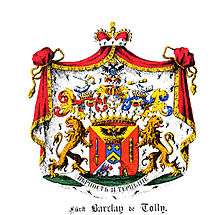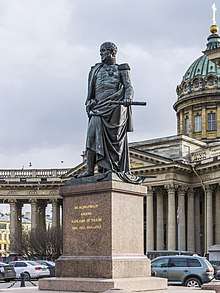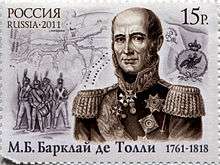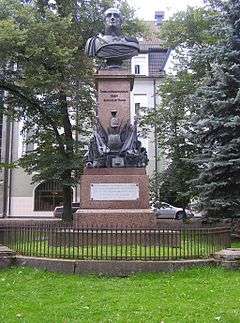Michael Andreas Barclay de Tolly
| General Prince Michael Andreas Barclay de Tolly | |
|---|---|
.jpg) Portrait of Barclay de Tolly from the Military Gallery of the Winter Palace, by George Dawe | |
| Born |
27 December 1761 Pamūšis, Courland and Semigallia |
| Died |
24 September [O.S. 12 September] 1818 Insterburg (Chernyakhovsk), Prussia |
| Buried | Jõgeveste, Estonia |
| Allegiance |
|
| Service/ | Imperial Russian Army |
| Years of service | 1776–1818 |
| Rank | Field Marshal |
| Commands held |
Governor-General of Finland Minister of War |
| Battles/wars | |
| Awards | Order of St. George |
Prince Michael Andreas Barclay de Tolly[nb 1] (German: Michael Andreas Fürst[1] Barclay de Tolly; 27 December [O.S. 16 December] 1761 – 26 May [O.S. 14 May] 1818) was a Baltic German Field Marshal and Minister of War of the Russian Empire during Napoleon's invasion in 1812 and War of the Sixth Coalition. Barclay implemented a number of reforms during this time that improved supply system in the army, doubled the number of army troops, and implemented new combat training principles. He was also the Governor-General of Finland.
He was born into a German-speaking noble family from Livonia who were members of the Scottish Clan Barclay. His father was the first of his family to be accepted into the Russian nobility. Barclay joined the Imperial Russian Army at a young age in 1776, enlisting in the Pskov Carabineer Regiment. For his role in the capture of Ochakov in 1788 from the Ottomans, he was personally decorated by Grigory Potemkin. Afterwards he participated in Catherine II's Swedish War. In 1794, he took part in putting down the Kościuszko Uprising in Poland and was again decorated for role in the capture of Vilnius.
In 1806, Barclay began commanding in the Napoleonic Wars, distinguishing himself at the Battle of Pułtusk that same year. He was wounded at the Battle of Eylau in 1807 while his troops were covering the retreat of the Russian army. Because of his wounds, he was forced to leave command. The following year, he carried out successful operations in the Finnish War against Sweden. Barclay led a large number of Russian troops approximately 100km across the frozen Gulf of Bothnia in winter during a snowstorm. For his accomplishments, Barclay de Tolly was appointed Governor-General of the Grand Duchy of Finland. From 20 January 1810 to September 1812 he was the Minister of War of the Russian Empire]].
When the French invasion of Russia began in 1812, Barclay de Tolly was commander of the 1st Army of the West, the largest Army to face Napoleon. Barclay was appointed Commander-in-Chief and initiated a scorched earth policy from the beginning of the campaign, though this made him unpopular among Russians. After the Battle of Smolensk failed to halt the French and discontent among Russians continued to grow, Alexander I appointed Mikhail Kutuzov as Commander-in-Chief, though Barclay remained in charge of the 1st Army. However, Kutuzov continued the same scorched earth retreat up to Moscow where the Battle of Borodino took place nearby. Barclay commanded the right wing and center of the Russian army for the battle. After Napoleon's retreat, the eventual success of Barclay's tactics made him a hero among Russians. He became Commander-in-Chief once again in 1813 after the death of Kutuzov and led the taking of Paris, for which he was made a Field Marshal. His health later declined and he died on a visit to Germany in 1818.
Early life and family
Barclay de Tolly, a member of the Scottish Clan Barclay with roots in Towie (Towy or Tolly, Scottish Gaelic: Tollaigh) in Aberdeenshire,[2] was born in Pamūšis,[3][4] Courland and Semigallia (in present-day Pakruojis District Municipality, Šiauliai County, Lithuania) and raised in Jõgeveste, Livonia, Russian Empire (now part of Estonia). The commonly accepted birth date of 27 December 1761 is actually the day of his baptism in the Lutheran church of the town Žeimelis.[5] He was a German-speaking descendant of a Scottish family: his ancestor Peter Barclay had settled in Livonia in the 17th century. From 1765 the young Barclay de Tolly grew up in Saint Petersburg and was raised by his aunt. Gregory Fremont-Barnes and Todd Fisher, who are amongst the world's leading Napoleonic-era scholars, state that this was a common occurrence amongst the German Protestants, and gave the young man an exposure to higher society unavailable in the Baltic provinces.[6] De Tolly's grandfather Wilhelm served as the mayor of Riga, while his father Bogdan Barclay de Tolly (1734-1781) had served in the Russian army before being admitted into the ranks of Russian nobility by the Tsar.[6] Mikhail Barclay de Tolly himself, the future field marshal, started active service in the Imperial Russian Army in 1776, and would spend the rest of his life with the military.[6]
Service history
Young Barclay was enlisted in the Pskov Carabineer Regiment on 13 May 1767, and achieved the rank of a cornet by May 1778. In the same year, he joined the Imperial jaeger regiments, and joined alongside the rest of his unit the army of Prince Potemkin.[6] In 1788–1789, during the Russo-Turkish War of 1787-1792, Barclay served against the Turks, under the command of Victor Amadeus of Anhalt-Bernburg-Schaumburg-Hoym. During this campaign, he distinguished himself in the taking of Ochakov and Akkerman. In 1789, he was transferred to the Finnish front during the Russo-Swedish War of 1788-1790,[6] and four years later, he fought against the Poles.[6] He was a lieutenant colonel by 1794 after serving as aide-de-camp to various senior officers in several campaigns. In that year he was appointed commander of the Estland Jaeger Corps, and three years later commander of the 4th Jaeger Regiment, becoming its chief in 1799, soon after being promoted to general major for his service in the Polish Campaign of 1794.[7]

In the war of 1806 against Napoleon, Barclay took a distinguished part in the Battle of Pultusk (December 1806) and was wounded at the Battle of Eylau (7 February 1807), where his conduct won him promotion to the rank of lieutenant general.[8] After a period of convalescence, Barclay returned to the army and in 1808 commanded operations against the Swedes during the Finnish War. In 1809, he successfully marched over the frozen Gulf of Bothnia, which allowed him to surprise the enemy and seize Umeå in Sweden.[8] For this exploit, immortalized by the Russian poet Baratynsky, he was made full general and Governor-General of Finland. A year later, he became Minister of War, retaining the post until 1813.[8]

Napoleon's invasion
During Napoleon's invasion of Russia in 1812, Barclay assumed the supreme command of the 1st Army of the West, the largest of the Russian armies facing Napoleon. He used a strategy of retreat leaving behind scorched earth from the beginning of the campaign in order to draw the French supply lines deep into Russian territory and retreated to the village of Tsaryovo-Zaimishche between Moscow and Smolensk, although some consider the strategy merely an confluence of diverse circumstances and not attributable to the will of one man.[9]
Nevertheless, the Russians keenly opposed the appointment of a foreigner as commander-in-chief. His rivals spread rumors of his being Napoleon's agent, and the populace condemned him as a coward. Barclay was forced by his subordinates and the Tsar to engage Napoleon at Smolensk (17–18 August 1812). Napoleon forced Barclay to retreat when he threatened Barclay's only escape route. After losing the Holy City of Smolensk, the outcry of officers and civilians grew to a point where the Tsar could no longer ignore it. He appointed Kutuzov, previously a general at the battle of Austerlitz, as the over-all commander of the Russian forces. Barclay remained General of the 1st Army of the West.
Barclay commanded the right flank at the Battle of Borodino (7 September 1812) with great valour and presence of mind and during the celebrated council at Fili advised Kutuzov to surrender unfortified Moscow to the enemy. His illness made itself known at that time and he was forced to leave the army soon afterwards.
After Napoleon was driven from Russia, the eventual success of Barclay's tactics made him a romantic hero, misunderstood by his contemporaries and rejected by the court. His popularity soared, and his honour was restored by the tsar.
Foreign campaigns
Barclay was re-employed in the field and took part in the German Campaign of 1813 and the French Campaign of 1814, which ended the War of the Sixth Coalition (1812–1814). After Kutuzov's death, he once again became commander-in-chief of the Russian forces at the Battle of Bautzen (21 May 1813), and in this capacity he served at Dresden (26–27 August 1813), Kulm (29–30 August 1813) and Leipzig (16–19 October 1813). In the latter battle he commanded a central part of the Allied forces so effectively that the tsar bestowed upon him the title of count.
Barclay took part in the invasion of France in 1814 and commanded the taking of Paris, receiving the baton of a Field Marshal in reward. In 1815 he again served as commander-in-chief of the Russian army which after the Hundred Days occupied France, and was created prince at the close of the war.
As his health grew worse, he left the military and settled down in his Jõgeveste manor (German exonym: Beckhof, Polish: Tepelshof) (nowadays Southern Estonia).[10] Barclay de Tolly died at Insterburg (Chernyakhovsk), East Prussia, on 26 May 1818 (14 May, Old Style) on his way from his Livonian manor to Germany, where he wanted to renew his health. His and his wife Helene Auguste Eleonore von Smitten's remains were embalmed and put into the mausoleum built to a design by Apollon Shchedrin and Vasily Demut-Malinovsky in 1832 in Jõgeveste (in Helme, Estonia).
A grand statue of him was erected in front of the Kazan Cathedral in St Petersburg on behest of Emperor Nicholas I. There are also a modern statue in Riga, a full size bronze mounted statue by Vladimir Surovtsev in Chernyakhovsk, a bust monument in Tartu, and the so-called "Barclay's leaning house" in Tartu (which was acquired by his widow after his death).
After the extinction of the Barclay de Tolly princely line with his son Magnus on 29 October 1871 (17 October, Old Style), Alexander II allowed the field marshal's sister's grandson through female lineage, Alexander von Weymarn, to assume the title of Prince Barclay de Tolly-Weymarn on 12 June 1872 (31 May, Old Style)[11]
Awards and decorations
- Order of St. Andrew (7 September 1813)
- Order of St. George - Barclay de Tolly was the second of four full Knights of St. George in the history of the Order. This includes his contemporary, Kutuzov;
- 1st class (19 August 1813, № 11) - "For the defeat of the French at the Battle of Kulm 18 August 1813";
- 2nd class bol.kr. (21 October 1812, № 44) - "For his part in the Battle of Borodino on 26 August 1812";
- 3rd class (8 January 1807, № 139) - "In the great reward of bravery and courage, rendered in the battle against the French troops on December 14th at Pultusk, where he commanded the vanguard ahead pravago flank, with a special skill and prudence kept the enemy at all times of battle and overturned Nadezhda";
- 4th class (16 September 1794, № 547) - "For outstanding courage, rendered against the Polish insurgents in the capture of fortifications and by the mountains. Villeneuve";
- Gold Sword for Bravery with diamonds and laurels with the inscription" for 20 January 1814" (1814);
- Order of St. Vladimir, 1st class (15 September 1811), 2nd class (7 March 1807), 4th class (12 July 1788);
- Order of St. Alexander Nevsky (9 September 1809); diamonds added (9 May 1813);
- Order of St. Anna, 1st class (7 March 1807);
- Golden Cross for taking Ochakov (7 December 1788);
- Cross "For the victory of Eylau" (1807);
- Order of the Red Eagle (Prussia, 1807);
- Order of the Black Eagle (Prussia, 1813);
- Commander of the Military Order of Maria Theresa (Austria, 1813);
- Order of the Sword, 1st class (Sweden, 1814);
- Grand Cross of the Legion of Honour, (France, 1815);
- Honorary Knight Grand Cross of the Order of the Bath, (UK, 1815);
- Sword with diamonds (UK, 1816);
- Military William Order, 1st class (Netherlands, 1815);
- Military Order of St. Henry, 1st class (Saxony, 1815);
- Order of Saint Louis, 1st class (France, 1816).
Commemoratives and legacy

- The Nesvizhskiy 4th Grenadier regiment (the General-Field Marshal Prince Barklay-de-Tolli, Mikhail Bogdanovich's) was named for the Prince in 1880s.
- He was also the namesake of a short-lived Russian fortress in the Hawaiian Islands.
- A statue of Barclay de Tolly was erected in 2001 in the Esplanade gardens in Riga, evoking an earlier 1913 monument that was destroyed during the 20th century.
- Whereas his lineage as a Baltic-Scottish Baron (and as such: Non-Russian) had caused him to be derided by Russian historians in the late 19th and throughout the 20th century in favor of Kutuzov, his image as a leader has undergone a positive reassessment in recent years.[12]
- The main-belt asteroid 4524 Barklajdetolli, discovered by Lyudmila Zhuravleva in 1981, was named in his honor.[13]
Notes
References
- ↑ Regarding personal names: Fürst is a title, translated as 'Prince', not a first or middle name. The feminine form is Fürstin.
- ↑
His ancestor emigrated from Towy (Tolly) in Aberdeenshire c. 1688.
"CHAPTER IX. SCOTTISH FAMILIES SETTLED IN RUSSIA. THE COURT PHYSICIANS. ROGERSON. OTHER SCOTS - SIR James WYLIE, COUNT BARCLAY DE TOLLY, LERMONTOFF. CONCLUSION.". Scottish Influences in Russian History. p. 6. Retrieved 2015-08-26.
The story of the family is this. They came to Russia during the times of the Revolution of 1688, from Towy (Tolly) in Aberdeenshire.
- ↑ (in Russian)Biography on the official website of the Russian Ministry of Defense Archived 2007-09-29 at the Wayback Machine.
- ↑ (in Lithuanian)Famous Russian officer is from Lithuania
- ↑ (in Lithuanian)The Evangelical Lutheran Church of Lithuania Archived 2007-09-27 at the Wayback Machine.
- 1 2 3 4 5 6 Fremont-Barnes & Fisher 2004, p. 172.
- ↑ p. 25, Mikaberidze, The Russian officer Corps
- 1 2 3 Nafziger 2001, p. 26.
- ↑ "War and Peace by graf Leo Tolstoy". Retrieved 4 April 2018 – via www.gutenberg.org.
- ↑ Anderson, Sten. "Hotell De Tolly". www.hotelldetolly.ee. Retrieved 4 April 2018.
- ↑ http://personen.digitale-sammlungen.de/baltlex/Blatt_bsb00000345,00442.html, http://personen.digitale-sammlungen.de/baltlex/Blatt_bsb00000345,00424.html
- ↑ "31 greatest commanders in Russian history". russian7.ru. Retrieved 2016-03-22.
- ↑ Schmadel, Lutz D. (2007). Dictionary of Minor Planet Names – (4524) Barklajdetolli. Springer Berlin Heidelberg. p. 389. ISBN 978-3-540-00238-3. Retrieved 20 June 2017.
Sources
- Fremont-Barnes, Gregory; Fisher, Todd (2004). The Napoleonic Wars: The Rise and Fall of an Empire. Fisher. ISBN 978-1841768311.
- Nafziger, George F. (2001). Historical Dictionary of the Napoleonic Era. Scarecrow Press. ISBN 978-0810866171.

Further reading
- Helme, Rein (2006). Kindralfeldmarssal Barclay de Tolly (in Estonian). Tallinn: Eesti Entsüklopeediakirjastus. ISBN 9985-70-202-6.
- Josselson, Michael; Josselson, Diana (1980). The Commander: A Life of Barclay de Tolly. Oxford: Oxford University Press. ISBN 0-19-215854-6.
- Mikaberidze, Alexander (2005). The Russian Officer Corps in the Revolutionary and Napoleonic Wars, 1792–1815. New York: Savas Beatie. ISBN 1-932714-02-2.
- Barclay de Tolly, Michael Andreas (1912). Image of hostilities in 1812 (in Russian). Saint Petersburg: Soykin. At Runivers.ru
External links
| Wikimedia Commons has media related to Michael Andreas Barclay de Tolly. |
- Barclay de Tolly
- Genealogisches Handbuch der Oeselschen Ritterschaft, de Tolly family tree in the Oesel Noble Corporation (in German)
- Pictures of the de Tolly statue in Riga at sites-of-memory.de
| Political offices | ||
|---|---|---|
| Preceded by Georg Magnus Sprengtporten |
Governor-General of Finland 1809–1810 |
Succeeded by Fabian Steinheil |
| Government offices | ||
| Preceded by Aleksey Arakcheyev |
Minister of Land Forces of Russia 1810–1812 |
Succeeded by Aleksey Gorchakov |

